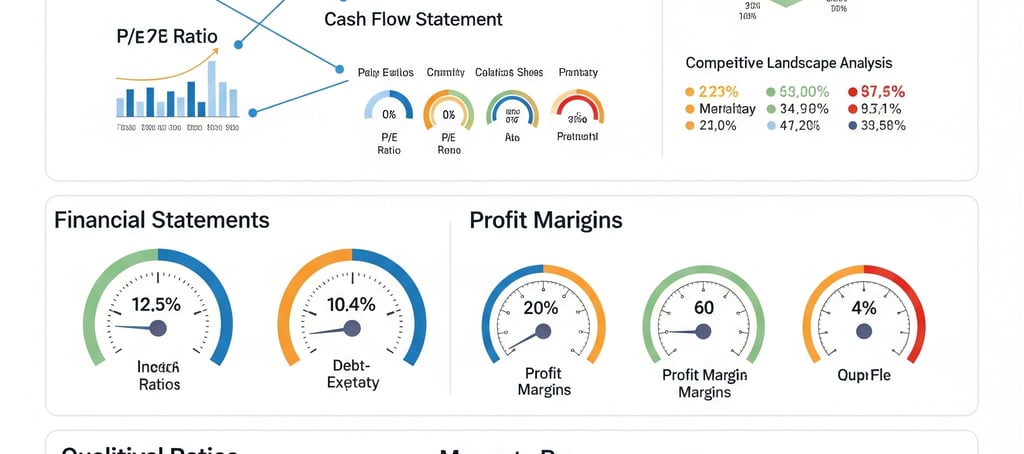Brief Introduction to Stock Analysis


Stocks, a cornerstone of financial markets since the Amsterdam Stock Exchange's inception in 1602, have empowered individuals to acquire a stake, however small, in the ownership of companies. As consumers and traders, our objective is often to navigate these markets, investing in companies we believe hold the promise of profitability within defined timeframes. Yet, this pursuit inherently begs the question: does this endeavor not introduce risk?
Indeed, like many aspects of life, stock trading is undeniably accompanied by risk. However, sophisticated traders employ various data-driven strategies to enhance the probability of successful trades. This exploration will delve into three pivotal areas: the fundamental nature of a stock, the critical company data points that demand scrutiny, and the significant news events to monitor.


At its core, a stock represents a fractional ownership in a company. When you purchase a share of stock, you are essentially buying a tiny piece of that corporation. This ownership grants you certain rights, which can vary depending on the type of stock you hold. For instance, common stock typically provides voting rights at shareholder meetings, allowing you to have a say in major company decisions. Preferred stock, on the other hand, usually doesn't come with voting rights but often offers a fixed dividend payment and a higher claim on assets in the event of liquidation. The value of your stock fluctuates based on market demand and the perceived future profitability of the company. As more investors believe a company will perform well, the demand for its stock increases, driving up its price. Conversely, if sentiment turns negative, the price can decline. This dynamic interplay of supply and demand, fueled by investor expectations and real-world company performance, is what makes the stock market so captivating and, at times, volatile.
What Exactly is a Stock?


For those looking to make informed trading decisions, a deep dive into a company's fundamental data is paramount. This information provides a comprehensive picture of a company's financial health, operational efficiency, and future prospects. One of the first places to look is the company's financial statements: the income statement, balance sheet, and cash flow statement. The income statement reveals a company's revenues, expenses, and ultimately its net income or loss over a specific period, offering insights into its profitability. The balance sheet, a snapshot in time, details a company's assets, liabilities, and shareholders' equity, providing a sense of its financial stability. The cash flow statement, perhaps the most critical for assessing liquidity, tracks the actual movement of cash in and out of the business from its operations, investments, and financing activities.
Beyond these core financial documents, a trader should also examine key financial ratios. For example, the Price-to-Earnings (P/E) ratio compares a company's current share price to its earnings per share, helping to determine if a stock is over or undervalued relative to its earnings. The Debt-to-Equity ratio assesses a company's leverage, indicating how much of its operations are financed by debt versus equity. Gross profit margin, operating profit margin, and net profit margin offer insights into a company's efficiency in generating profits from its sales. Furthermore, understanding a company's competitive landscape, its management team's experience and vision, and its unique selling propositions are crucial qualitative factors that can significantly influence its long-term success and, by extension, its stock performance. Analyzing these data points in conjunction provides a holistic view, enabling a more informed decision-making process.
Essential Company Data to Analyze


In the fast-paced world of stock trading, staying abreast of relevant news is as crucial as analyzing historical data. News can act as a powerful catalyst, rapidly shifting market sentiment and stock prices. One of the most impactful categories of news is earnings reports. These quarterly or annual releases detail a company's financial performance, often exceeding or falling short of analyst expectations. A significant beat or miss can send a stock soaring or plummeting in a matter of hours.
Beyond earnings, macroeconomic news plays a vital role. Interest rate decisions by central banks, inflation data, employment figures, and GDP growth reports can all have widespread effects on the broader market and individual sectors. For instance, an unexpected interest rate hike might negatively impact growth stocks, while strong employment numbers could signal a robust economy, boosting overall market confidence. Industry-specific news is also paramount. New product launches, regulatory changes, mergers and acquisitions, and technological breakthroughs within a particular sector can significantly impact the companies operating within it.
Geopolitical events, ranging from trade disputes to international conflicts, can create widespread uncertainty and volatility across global markets. Even seemingly minor events can have ripple effects if they impact supply chains, consumer confidence, or investor sentiment. Therefore, a diligent trader maintains a constant vigil on a diverse range of news sources, understanding that the timely assimilation and interpretation of information can provide a significant edge in navigating the dynamic currents of the stock market.
News to Be On the Lookout For


The world of stock trading, while undoubtedly carrying inherent risks, is also an arena where informed decisions can lead to significant opportunities. From its origins in 17th-century Amsterdam to today's interconnected global markets, stocks have consistently offered individuals a pathway to participate in corporate growth. By diligently understanding what a stock fundamentally represents, meticulously analyzing crucial company data, and staying acutely aware of the ever-flowing stream of news, traders can equip themselves with the knowledge necessary to navigate these complex waters. While the future remains uncertain, a data-driven approach, combined with a keen eye on market-moving events, significantly enhances the probability of making more likely trades and achieving one's financial objectives within the exciting and challenging realm of stock market investing.
